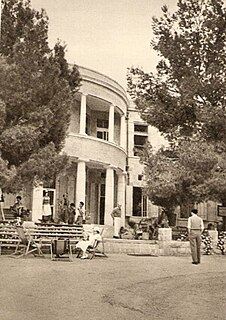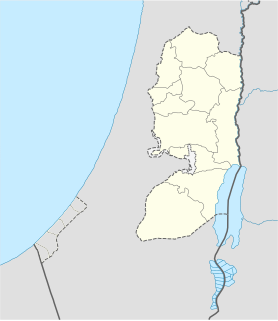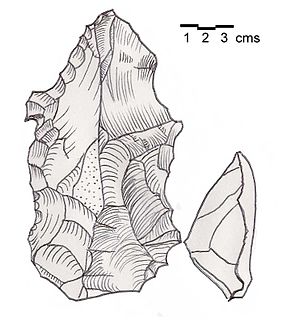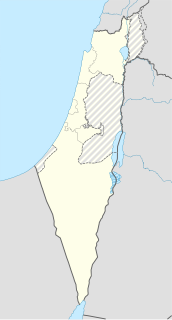Related Research Articles

Motza, also Mozah or Motsa, is a neighbourhood on the western edge of West Jerusalem. It is located in the Judean Hills, 600 metres above sea level, connected to Jerusalem by the Jerusalem–Tel Aviv highway and the winding mountain road to Har Nof. Established in 1854, Motza was the first Jewish farm founded outside the walls of the Old City in the modern era. It is believed to be located on the site of a Biblical village of the same name mentioned in Joshua 18:26.

In the archaeology of Southwest Asia, the Late Neolithic, also known as the Ceramic Neolithic or Pottery Neolithic, is the final part of the Neolithic period, following on from the Pre-Pottery Neolithic and preceding the Chalcolithic. It began around 6,400 BCE in the Fertile Crescent, succeeding the period of the Pre-Pottery Neolithic. By then distinctive cultures emerged, with pottery like the Halafian and Ubaid. This period has been further divided into PNA and PNB at some sites.

Kfar HaHoresh is a kibbutz in northern Israel. Located near Nazareth, it falls under the jurisdiction of Jezreel Valley Regional Council. In 2019 it had a population of 699.

Yosef Garfinkel is a professor of Prehistoric Archaeology and of Archaeology of the Biblical Period at the Hebrew University of Jerusalem.

Yiftahel is an archaeological site located in the Lower Galilee in northern Israel. Various salvage excavations took place here between 1992 and 2008. The best known periods of occupation are the Early Bronze Age I and Pre-Pottery Neolithic B.
Tel Ali is an archaeological site located one mile south of the Sea of Galilee, in the central Jordan Valley, Israel. It has been excavated twice. First, during the years 1955–1959, Moshe Prausnitz conducted salvage excavations on behalf of the Israel Department of Antiquities. He published only preliminary reports and most of the excavation finds remained unstudied. Prausnitz uncovered a detailed sequence of occupation including: Pre-Pottery Neolithic B, Pre-Pottery Neolithic C, Pottery Neolithic B, Middle Chalcolithic and Late Chalcolithic (Ghassulian). However, at the time of excavation many of these phases had not yet been defined.

Gesher is an archaeological site located on the southern bank of Nahal Tavor, near kibbutz Gesher in the central Jordan Valley of Israel. It bears signs of occupation from two periods, the very early Neolithic and the Middle Bronze Age. The site was first excavated between 1986 and 1987 by Yosef Garfinkel of the Hebrew University of Jerusalem and between 2002 and 2004 by Susan Cohen of Montana State University. The average of 4 radiocarbon dating results suggested inhabitation of the settlement around 8000 BC.

The Yarmukian culture was a Pottery Neolithic A (PNA) culture of the ancient Levant. It was the first culture in prehistoric Israel and one of the oldest in the Levant to make use of pottery. The Yarmukian derives its name from the Yarmuk River, which flows near its type site of Sha'ar HaGolan, near Kibbutz Sha'ar HaGolan at the foot of the Golan Heights. This culture existed alongside the Lodian, or Jericho IX culture and the Nizzanim culture to the south.

Abu Zurayq is an archaeological site named after the modern village that existed there, located on the western edge of the Jezreel Valley and its transition to the Menashe Heights. It is located next to Highway 66, between the modern kibbutzim of HaZore'a and Mishmar HaEmek.

Baysamun or Beisamoun was a small Palestinian Arab village, located 16.5 kilometers (10.3 mi) in the marshy Hula Valley northeast of Safad. In 1945, it had a population of 20. It was depopulated during the 1948 War on May 25, 1948 by the Palmach's First Battalion in Operation Yiftach.

Gilgal I is an archaeological site in the Jordan Valley, West Bank, dated to the early Neolithic period. The site is located eight miles north of ancient Jericho. The features and artifacts unearthed at Gilgal I shed important light on agriculture in the Levant. The by far oldest domesticated figs found anywhere in the world were recovered from an incinerated house at the site, and have been described as coming from cultivated, as opposed to wild, fig trees.
Adrian Nigel Goring-Morris is a British-born Archaeologist and a Professor at the Hebrew University of Jerusalem in Israel. He completed his PhD there in 1986 and is notable for his work and discoveries at one of the oldest ritual burial sites in the world; Kfar HaHoresh. The earliest levels of this site have been dated to 8000 BC and it is located in the northern Israel, not far from Nazareth.
Avi Gopher is an Israeli archaeologist. He is a professor at the University of Tel Aviv.

Heavy Neolithic is a style of large stone and flint tools associated primarily with the Qaraoun culture in the Beqaa Valley, Lebanon, dating to the Epipaleolithic or early Pre-Pottery Neolithic at the end of the Stone Age. The type site for the Qaraoun culture is Qaraoun II.

Nahal Issaron is a wadi and neolithic settlement in southern Negev, Israel. It is located at the eastern edge of Biqat Uvda, 35 kilometres (22 mi) north of the Gulf of Elat and 5 kilometres (3.1 mi) west of Arabah Rift valley. Excavations carried out by Avi Gopher and Nigel Goring-Morris in Nahal Issaron in 1980 uncovered remnants of an early pastoralist settlement belonging to the Pre-Pottery Neolithic B period.

Kharaysin is a Pre-Pottery Neolithic site (PPN) located in the village of Quneya, at the Zarqa River valley, Jordan. This site was discovered in 1984 by Hanbury-Tenison and colleagues during the Jerash Region Survey. The site was allocated to the Pre-Pottery Neolithic B because of the analysis of archaeological artefacts recovered on the surface.

The Lodian culture or Jericho IX culture is a Pottery Neolithic archaeological culture of the Southern Levant dating from the first half of the 5th millennium BC, existing alongside the Yarmukian and Nizzanim cultures. The Lodian culture appears mainly in areas south of the territory of the Yarmukian culture, in the Shfela and the beginning of the Israeli coastal plain, the Judaean Mountains and in the desert regions around the Dead Sea and south of it.
The Wadi Rabah culture is a Pottery Neolithic archaeological culture of the Southern Levant, dating to the middle of the 5th millennium BCE.
Sha'ar HaGolan is a Neolithic archaeological site near Kibbutz Sha'ar HaGolan in Israel. The type site of the Yarmukian culture, it is notable for the discovery of a significant number of artistic objects, as well as some of the earliest pottery in the Southern Levant.

Tel Shem, or Tell esh Shemmam, is an archaeological site located south of Kfar Yehoshua, in the Jezreel Valley, northern Israel. The Nahalal stream, a tributary of the Kishon River, flows east of the site. The site used to include a tell but it was flattned for agricultural use and it can no longer be seen on the surface. Fragments of building blocks and potsherds can be found scattered on the agricultural fields around the site and are usually exposed after the rain. Residents of Kfar Yehoshua have collected ancient artifacts from the site and put them as decorations in their homes. Those include complete vessels and figurines made of stone and pottery. The site was surveyed by Israeli archaeologist Avner Raban and a salvage excavation took place for the first time in 2013. The studies showed that although small, Tel Shem had human presence through almost every period from the Neolithic until the Byzantine rule, as well as during the Mamluk and Ottoman periods. A station of the old Jezreel Valley railway near Kfar Yehoshua was named after the site which was still visible in the beginning of the 20th century, before it was changed to "Kfar Yehoshua Station".
References
- ↑ "The 2007–8 excavation seasons at Pre-Pottery Neolithic B Kfar HaHoresh, Israel". Antiquity . Durham University. 82 (318). December 2008. Archived from the original on September 15, 2016.